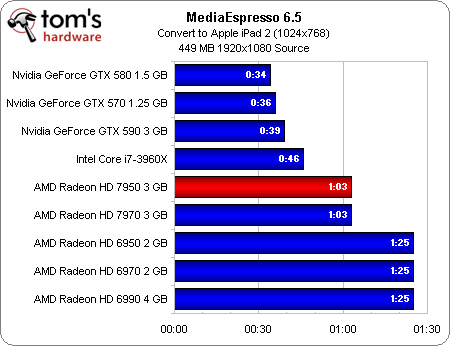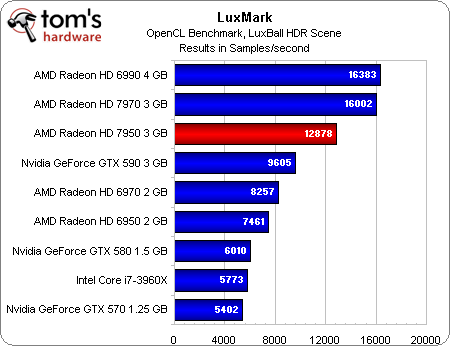AMD Radeon HD 7950 Review: Up Against GeForce GTX 580
Benchmark Results: MediaEspresso 6.5 And LuxMark
This was perhaps the most disappointing chart we encountered. CyberLink generally does a great job of supporting new GPU-based technologies, and we’ve used special versions of its MediaEspresso software in the past to analyze the visual quality of AMD’s accelerated output.
However, we tried three versions of the software: the latest demo, the latest press room-based review copy, and a third with certain features that we can’t disclose yet. None of them made hardware-accelerated encoding available on the AMD cards. Decoding was available, but as you can see, it’s faster to disable AMD's UVD 3 block and use Intel’s Core i7-3960X for the job instead.
Although MediaEspresso also defaults to using accelerated encode-only on the Nvidia cards, we turned on decoding as well. The resulting speed-up is noticeable compared to the software-only approach.
The biggest bummer is that AMD still hasn’t enabled the Video Codec Engine purportedly built into its Radeon HD 7900-series cards. This fixed-function hardware is supposedly not any faster on its own than encoding collaboratively with the programmable hardware. However, in light of the fact that we can’t use the shader hardware on its own, even with the latest Media Codec Package installed, AMD’s performance story in MediaEspresso ends with a whimper.
AMD’s OpenCL performance under LuxMark is much more promising. This tool, derived from the LuxRenderer engine, is a real-world representation of OpenCL-based performance that reports its result in samples per second.
Don’s Radeon HD 7970 launch coverage mentioned that GCN was architected to greatly improve compute performance, and these numbers validate that claim by blowing right past Nvidia’s dual-GPU GeForce GTX 590. The single-GPU Radeon HD 7970 nearly matches pace with the dual-GPU Radeon HD 6990.
Get Tom's Hardware's best news and in-depth reviews, straight to your inbox.
Current page: Benchmark Results: MediaEspresso 6.5 And LuxMark
Prev Page Benchmark Results: Sandra 2012 Next Page Benchmark Results: vReveal-
Im not Paying $450 for barely better then GTX 580 performance a year after its released. They will have to knock that down to like $300, $250 for a 2gb version when Nvidia releases their next gen cards. Wait those money grubers out imo.Reply
-
thesnappyfingers stm I was thinking the same thing. But then agian it is still cheaper, more efficient compared to the gtx 580. Still, I am waiting it out till kepler.Reply -
rmpumper 7950/7970 should be priced ~$50+ of 6950/6970 prices. So as it is now, if nvidia's gtx680 will be better than 7970 they will price it at >$600? That's a load of crock.Reply -
Derbixrace great value compared to the 7970 because you can OC it to be faster than it on stock voltage and even further with voltage tweaking ;)Reply -
esrever I'd love to have one once kepler comes and these drop in price. Im gonna start saving.Reply -
It beats the GTX580 one on one in most benchies and that's not taking into account the overclocking headroom these things have, they're also power friendlier and with XFX, cooler, quieter and expected to be cheaper so what's the problem? Me thinks me smell's NV fanboys!!Reply
-
dragonsqrrl rmpumper7950/7970 should be priced ~$50+ of 6950/6970 prices. So as it is now, if nvidia's gtx680 will be better than 7970 they will price it at >$600? That's a load of crock.Every rumor and leak I've seen so far on gk104 pricing seems to indicate otherwise...Reply
http://www.guru3d.com/news/nvidia-gk104-kepler-gpu-priced-at-299-230-/
According to Nvidia's AIB partners the initial price set for the first gk104 based graphics card is $300. Of course this can go up or down based on the competition. Unfortunately, I have the feeling it'll be going up.


